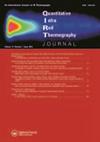医用红外热像中人体部位和姿态的自动检测
IF 4.9
3区 工程技术
Q1 INSTRUMENTS & INSTRUMENTATION
引用次数: 9
摘要
医学红外热成像(MITI)诊断过程的自动化和标准化至关重要,因为该领域的医学专家数量非常有限。目前的研究一般需要人工干预。其中一项手工操作需要医生确定身体部位和方位。本文研究了医学热图像的姿态和身体部位自动检测。数据库(957张热图像- 59例患者)分为4类上下身体部位,前后视图。首先,对使用Otsu阈值法确定的主体内的像素点应用直方图均衡化(HE)方法;其次,采用DarkNet-19架构进行特征提取,采用主成分分析(PCA)和t分布随机邻居嵌入(t-SNE)方法进行特征选择;最后,分析了各种基于机器学习的分类方法的性能。上半身与下半身、上半身后与前分类准确率100%,下半身后与前分类成功率93.38%。这种方法将改进热图像的自动化过程,将它们分组以便与其他图像进行比较,并以更友好的方式对标记的图像执行查询。本文章由计算机程序翻译,如有差异,请以英文原文为准。
Automatic body part and pose detection in medical infrared thermal images
ABSTRACT Automatisation and standardisation of the diagnosis process in medical infrared thermal imaging (MITI) is crucial because the number of medical experts in this area is highly limited.The current studies generally need manual intervention. One of the manual operations requires physician’s determination of the body part and orientation. In this study automatic pose and body part detection on medical thermal images is investigated. The database (957 thermal images - 59 patients) was divided into four classes upper-lower body parts with back-front views. First, histogram equalization (HE) method was applied on the pixels only within the body determined using Otsu’sthresholding approach. Secondly, DarkNet-19 architecture was used for feature extraction, and principal component analysis (PCA) and t-distributed stochastic neighbour embedding (t-SNE) approaches for feature selection. Finally, the performances of various machine learning based classification methods were examined. Upper vs. lower body parts and back vs. front of upper body were classified with 100% accuracy, and back vs. front classification of lower body part success rate was 93.38%. This approach will improve the automatisation process of thermal images to group them for comparing one image with the others and to perform queries on the labeled images in a more user-friendly manner.
求助全文
通过发布文献求助,成功后即可免费获取论文全文。
去求助
来源期刊

Quantitative Infrared Thermography Journal
Physics and Astronomy-Instrumentation
CiteScore
6.80
自引率
12.00%
发文量
17
审稿时长
>12 weeks
期刊介绍:
The Quantitative InfraRed Thermography Journal (QIRT) provides a forum for industry and academia to discuss the latest developments of instrumentation, theoretical and experimental practices, data reduction, and image processing related to infrared thermography.
 求助内容:
求助内容: 应助结果提醒方式:
应助结果提醒方式:


